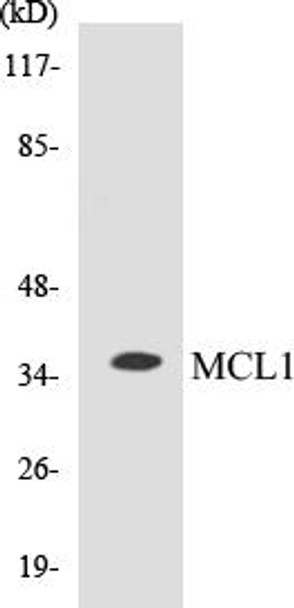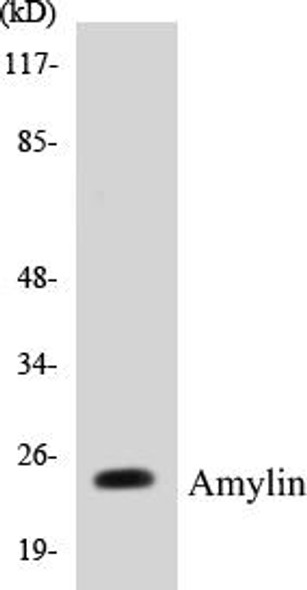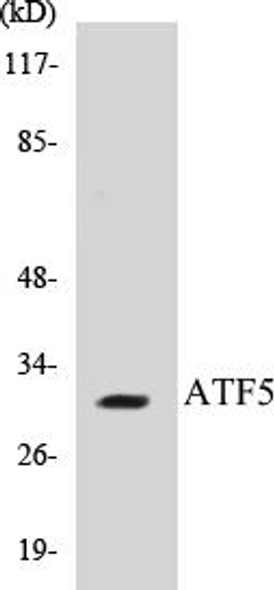Description
MCL1 Colorimetric Cell-Based ELISA Kit
The MCL1 Colorimetric Cell-Based ELISA Kit from Assay Genie is designed for the accurate detection of MCL1 levels in cell lysates and tissue homogenates. This kit offers high sensitivity and specificity, ensuring dependable and consistent results for your research needs.MCL1 is a critical protein that plays a key role in regulating cell survival and apoptosis. Dysregulation of MCL1 has been implicated in various diseases, including cancer and neurodegenerative disorders, making it an important biomarker for studying these conditions and exploring potential treatment options.
With the MCL1 Colorimetric Cell-Based ELISA Kit, researchers can easily quantify MCL1 levels in their samples and gain valuable insights into the role of this protein in disease pathology. Trust Assay Genie for reliable and accurate results in your research endeavors.
| Product Name: | MCL1 Colorimetric Cell-Based ELISA |
| Product Code: | CBCAB00747 |
| ELISA Type: | Cell-Based |
| Target: | MCL1 |
| Reactivity: | Human, Mouse, Rat |
| Dynamic Range: | > 5000 Cells |
| Detection Method: | Colorimetric 450 nmStorage/Stability:4°C/6 Months |
| Format: | 96-Well Microplate |
The MCL1 Colorimetric Cell-Based ELISA Kit is a convenient, lysate-free, high throughput and sensitive assay kit that can detect MCL1 protein expression profile in cells. The kit can be used for measuring the relative amounts of MCL1 in cultured cells as well as screening for the effects that various treatments, inhibitors (ie siRNA or chemicals), or activators have on MCL1.
Qualitative determination of MCL1 concentration is achieved by an indirect ELISA format. In essence, MCL1 is captured by MCL1-specific primary antibodies while the HRP-conjugated secondary antibodies bind the Fc region of the primary antibody. Through this binding, the HRP enzyme conjugated to the secondary antibody can catalyze a colorimetric reaction upon substrate addition. Due to the qualitative nature of the Cell-Based ELISA, multiple normalization methods are needed:
| 1. | A monoclonal antibody specific for human GAPDH is included to serve as an internal positive control in normalizing the target absorbance values. |
| 2. | Following the colorimetric measurement of HRP activity via substrate addition, the Crystal Violet whole-cell staining method may be used to determine cell density. After staining, the results can be analysed by normalizing the absorbance values to cell amounts, by which the plating difference can be adjusted. |
| Database Information: | Gene ID: 4170, UniProt ID: Q07820, OMIM: 159552, Unigene: Hs.632486 |
| Gene Symbol: | MCL1 |
| Sub Type: | None |
| UniProt Protein Function: | MCL1: a myeloid cell leukemia protein of the Bcl-2 family of proteins. Two alternatively spliced transcripts encoding distinct isoforms have been identified. The longer gene product (isoform 1) enhances cell survival by inhibiting apoptosis while the alternatively spliced shorter gene product (isoform 2) promotes apoptosis and is death-inducing. |
| UniProt Protein Details: | Protein type:Inhibitor; Apoptosis; Mitochondrial; Channel, misc.; Membrane protein, integral Chromosomal Location of Human Ortholog: 1q21 Cellular Component: nucleoplasm; mitochondrial outer membrane; mitochondrion; membrane; mitochondrial matrix; cytoplasm; integral to membrane; cytosol; nucleus Molecular Function:protein binding; protein homodimerization activity; protein heterodimerization activity; protein channel activity; BH3 domain binding Biological Process: apoptotic mitochondrial changes; DNA damage response, signal transduction resulting in induction of apoptosis; response to cytokine stimulus; multicellular organismal development; cellular homeostasis; cell fate determination |
| NCBI Summary: | This gene encodes an anti-apoptotic protein, which is a member of the Bcl-2 family. Alternative splicing results in multiple transcript variants. The longest gene product (isoform 1) enhances cell survival by inhibiting apoptosis while the alternatively spliced shorter gene products (isoform 2 and isoform 3) promote apoptosis and are death-inducing. [provided by RefSeq, Oct 2010] |
| UniProt Code: | Q07820 |
| NCBI GenInfo Identifier: | 83304396 |
| NCBI Gene ID: | 4170 |
| NCBI Accession: | Q07820.3 |
| UniProt Secondary Accession: | Q07820,Q9HD91, Q9NRQ3, Q9NRQ4, Q9UHR7, Q9UHR8, Q9UHR9 Q9UNJ1, B2R6B2, D3DV03, D3DV04, |
| UniProt Related Accession: | Q07820 |
| Molecular Weight: | 350 |
| NCBI Full Name: | Induced myeloid leukemia cell differentiation protein Mcl-1 |
| NCBI Synonym Full Names: | myeloid cell leukemia 1 |
| NCBI Official Symbol: | MCL1 |
| NCBI Official Synonym Symbols: | TM; EAT; MCL1L; MCL1S; Mcl-1; BCL2L3; MCL1-ES; bcl2-L-3; mcl1/EAT |
| NCBI Protein Information: | induced myeloid leukemia cell differentiation protein Mcl-1; bcl-2-like protein 3; myeloid cell leukemia ES; bcl-2-related protein EAT/mcl1; myeloid cell leukemia sequence 1 (BCL2-related) |
| UniProt Protein Name: | Induced myeloid leukemia cell differentiation protein Mcl-1 |
| UniProt Synonym Protein Names: | Bcl-2-like protein 3; Bcl2-L-3; Bcl-2-related protein EAT/mcl1; mcl1/EAT |
| Protein Family: | Minichromosome loss protein |
| UniProt Gene Name: | MCL1 |
| UniProt Entry Name: | MCL1_HUMAN |
| Component | Quantity |
| 96-Well Cell Culture Clear-Bottom Microplate | 2 plates |
| 10X TBS | 24 mL |
| Quenching Buffer | 24 mL |
| Blocking Buffer | 50 mL |
| 15X Wash Buffer | 50 mL |
| Primary Antibody Diluent | 12 mL |
| 100x Anti-Phospho Target Antibody | 60 µL |
| 100x Anti-Target Antibody | 60 µL |
| Anti-GAPDH Antibody | 60 µL |
| HRP-Conjugated Anti-Rabbit IgG Antibody | 12 mL |
| HRP-Conjugated Anti-Mouse IgG Antibody | 12 mL |
| SDS Solution | 12 mL |
| Stop Solution | 24 mL |
| Ready-to-Use Substrate | 12 mL |
| Crystal Violet Solution | 12 mL |
| Adhesive Plate Seals | 2 seals |
The following materials and/or equipment are NOT provided in this kit but are necessary to successfully conduct the experiment:
- Microplate reader able to measure absorbance at 450 nm and/or 595 nm for Crystal Violet Cell Staining (Optional)
- Micropipettes with capability of measuring volumes ranging from 1 µL to 1 ml
- 37% formaldehyde (Sigma Cat# F-8775) or formaldehyde from other sources
- Squirt bottle, manifold dispenser, multichannel pipette reservoir or automated microplate washer
- Graph paper or computer software capable of generating or displaying logarithmic functions
- Absorbent papers or vacuum aspirator
- Test tubes or microfuge tubes capable of storing ≥1 ml
- Poly-L-Lysine (Sigma Cat# P4832 for suspension cells)
- Orbital shaker (optional)
- Deionized or sterile water
*Note: Protocols are specific to each batch/lot. For the correct instructions please follow the protocol included in your kit.
| Step | Procedure |
| 1. | Seed 200 µL of 20,000 adherent cells in culture medium in each well of a 96-well plate. The plates included in the kit are sterile and treated for cell culture. For suspension cells and loosely attached cells, coat the plates with 100 µL of 10 µg/ml Poly-L-Lysine (not included) to each well of a 96-well plate for 30 minutes at 37°C prior to adding cells. |
| 2. | Incubate the cells for overnight at 37°C, 5% CO2. |
| 3. | Treat the cells as desired. |
| 4. | Remove the cell culture medium and rinse with 200 µL of 1x TBS, twice. |
| 5. | Fix the cells by incubating with 100 µL of Fixing Solution for 20 minutes at room temperature. The 4% formaldehyde is used for adherent cells and 8% formaldehyde is used for suspension cells and loosely attached cells. |
| 6. | Remove the Fixing Solution and wash the plate 3 times with 200 µL 1x Wash Buffer for five minutes each time with gentle shaking on the orbital shaker. The plate can be stored at 4°C for a week. |
| 7. | Add 100 µL of Quenching Buffer and incubate for 20 minutes at room temperature. |
| 8. | Wash the plate 3 times with 1x Wash Buffer for 5 minutes each time. |
| 9. | Add 200 µL of Blocking Buffer and incubate for 1 hour at room temperature. |
| 10. | Wash 3 times with 200 µL of 1x Wash Buffer for 5 minutes each time. |
| 11. | Add 50 µL of 1x primary antibodies (Anti-MCL1 Antibody and/or Anti-GAPDH Antibody) to the corresponding wells, cover with Parafilm and incubate for 16 hours (overnight) at 4°C. If the target expression is known to be high, incubate for 2 hours at room temperature. |
| 12. | Wash 3 times with 200 µL of 1x Wash Buffer for 5 minutes each time. |
| 13. | Add 50 µL of 1x secondary antibodies (HRP-Conjugated AntiRabbit IgG Antibody or HRP-Conjugated Anti-Mouse IgG Antibody) to corresponding wells and incubate for 1.5 hours at room temperature. |
| 14. | Wash 3 times with 200 µL of 1x Wash Buffer for 5 minutes each time. |
| 15. | Add 50 µL of Ready-to-Use Substrate to each well and incubate for 30 minutes at room temperature in the dark. |
| 16. | Add 50 µL of Stop Solution to each well and read OD at 450 nm immediately using the microplate reader. |
(Additional Crystal Violet staining may be performed if desired – details of this may be found in the kit technical manual.)






